Since the adoption of the Challenge System for major FIVB events in 2012, fans have been more engaged with the calls on the court. However since using the Hawk-Eye System in 2014, fans love the in match display with the line challenges.
What we don’t realize as fans is that Hawk-Eye is tracking the ball constantly in play and that this can be shown as detailed data to both fans and coaches. Japan’s NHK broadcasting program “Sports Innovation” on September 10th presented a 30 minute story on Japan’s match with Brazil from the 2017 World Grand Prix on July 16th. Japan defeated Brazil 3-2, which was their first win over Brazil in 6 years. Some of the data that I saw in the program, in addition to discussion with Japanese coach Kumi Nakata and setter Miya Sato about their way of attacking the Brazilians and timing of plays with the data gave great insight into the way strategy works in a match.
As fans we know that passing well and to the target area for the setter helps the offense be successful. In the following picture, you will see the location of where the setter contacted the ball for both Japan and Brazil in the first set of the match.
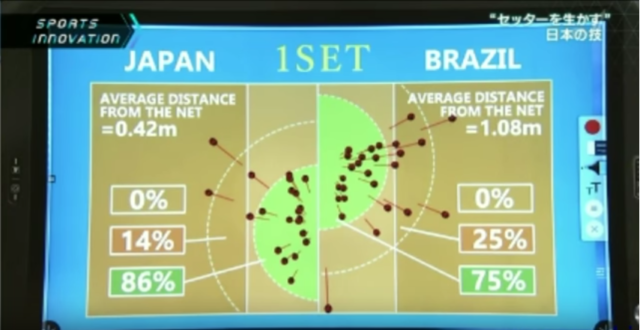
Courtesy NHK and Masa Yuki youtube page
The green arcs are 3 meters from the setter target spot near the net. The further dashed line arcs are 6 meters from the target spot. From the graphic, Japan did a better job of putting the ball in a spot for the Japanese attack compared to the Brazilians. Japan did win the first set 25-22.
But lets advance from passing to where the setter contacts the ball in the air before the spike. This is a display of Japan’s setter contact points throughout the match.
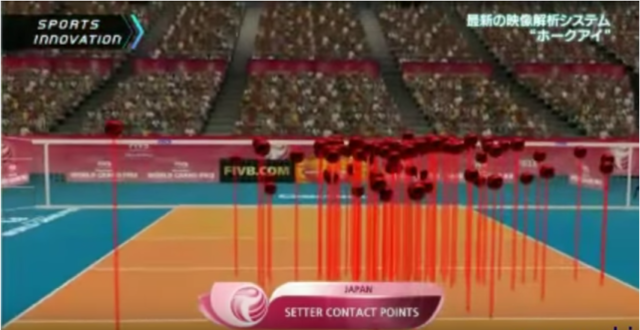
Courtesy NHK and Masa Yuki youtube page
One of the things that we do not realize as fans is that if the ball is contacted near the top of the net, the ball can move faster to the wings. NHK even showed an example
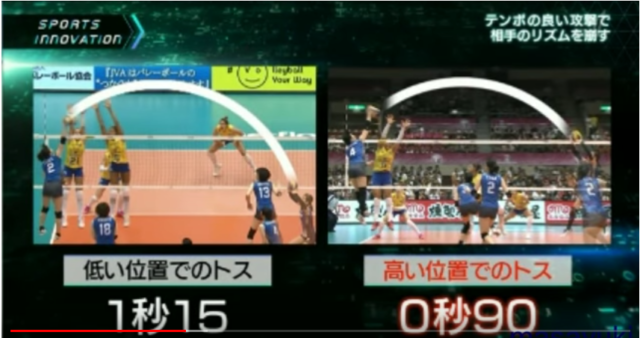
Courtesy NHK and Masa Yuki youtube page
In the picture from this match, the set from near the top of the net to the left wing took 0.90 seconds. While one that was set from below the net, took 1.15 seconds. This quarter of a second difference is crucial for Japan to be successful. If Japan has to face a two person block, it might be coming back. Whereas if it a single person block, their chance to score is higher.
As Brazil had lost the first two sets of the match, the Brazilians decided to make a change to their service game. As shown below in the 3rd and 4th set Brazil shifted their serving to the left side of Japan’s attack.
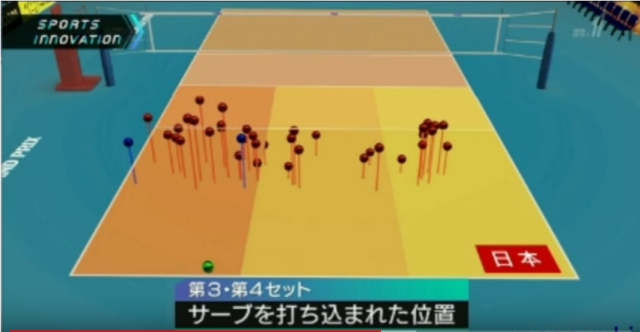
Courtesy NHK and Masa Yuki youtube page
Why did they do this? When the setter was in the front row, Japan only had two hitters in the front row. By serving the left side of the court, Brazil kept Japan from attacking with the front row on the right side of the court. By doing this, Brazil then shrank the blocking side of the court for by 1/3rd or more.
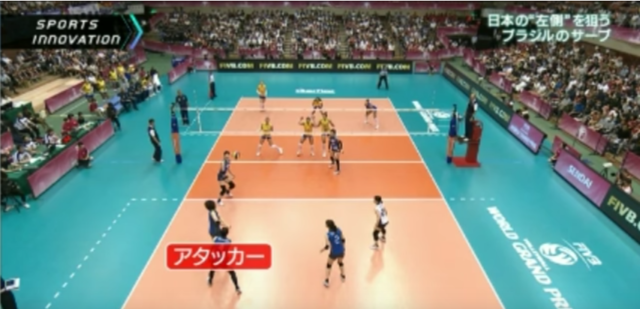
Courtesy NHK and Masa Yuki youtube page
In the photo you can see Japan’s serve receive just after contact on their side of the court with a front row setter. Brazil’s block is almost ready to double block the middle hitter immediately. If the setter goes outside to the left, the Brazilians could possibly put up a triple block easily. Without the combination of Hawk-Eye and later analysis, we would have not have realized the adjustments that Brazil made to win sets 3 and 4 in the match.
Lastly, Hawk-Eye even takes the serve and helps demonstrate the location and speed.
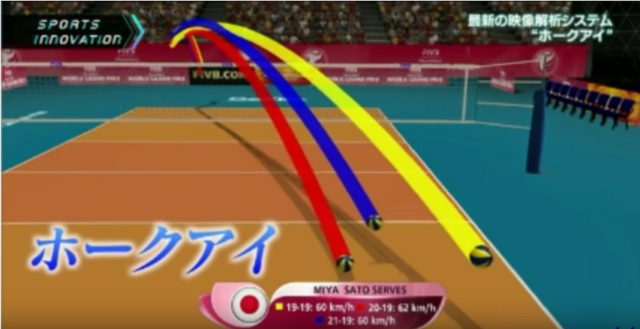
Courtesy NHK and Masa Yuki youtube page
Miya Sato had three straight serves in the first set at 19-19. She had an ace on the first serve (yellow) at 37.2 mph (60 km/h). On her second serve at 20-19, after a Brazil time out, she hit it a little harder 38.5 mph (62 km/h), but it dropped shorter. Brazil overpassed and caused the setter Roberta to be called for a net when trying to push the ball into the Japanese court. On the third serve at 21-19, Sato’s serve was back at 37.2 mph, and dropped even shorter into the court. The third serve was again overpassed into a free ball for Japan, which they promptly killed to take a 22-19 lead. As you can see in the shot, the three balls basically tracked in the same spot to the net. Only at the net did the ball diverge to their final destination. The ability to have that deception on serve will win teams points and matches.
Without Hawk-Eye, fans cannot see this incredible detail on ball movement on serve, serve receive locations, setting height and passing efficiency. FIVB, please show more of this during time outs and between the set breaks. It will help the fans see what is going on and even help the broadcasters as well. Now if only they could have dig locations on the court?
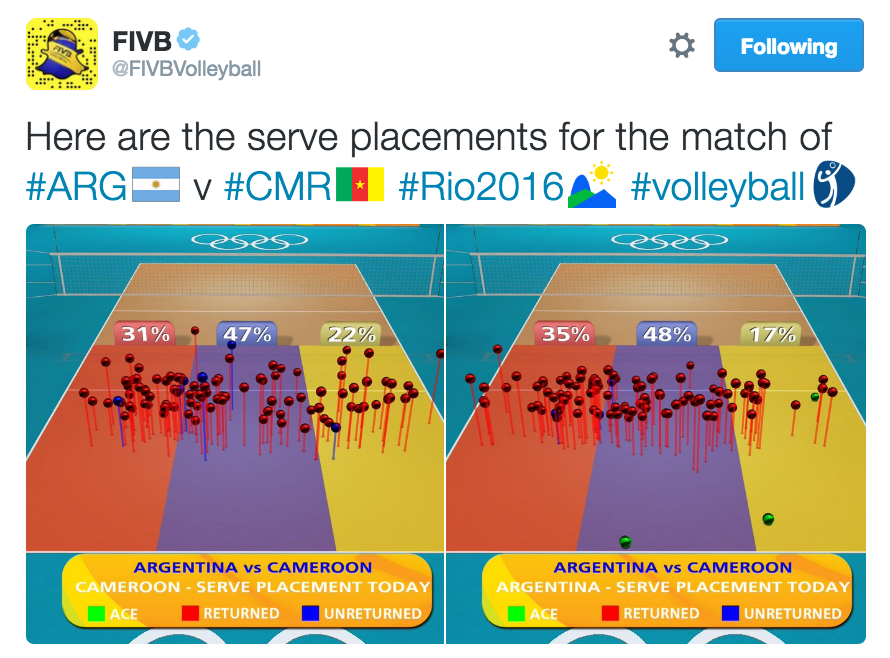
These graohics are fantastic. We should definitely see more of them. They would be a welcome addition to volleyball telecasts.
However, the information is not new. A skilled analyst would be able to talk about setter position and recognise and communicate immediately a change in serving tactics. Unfortunately TV normally focuses on the mundane and obvious and FIVB has shown no leadership at all in how it uses commentators in its own broadcasts. As a result generations of causal have never been exposed to the intricacies of the game and never learnt to appreciate the beauty of the game that lies beneath the surface.
Excellent!
Awesome